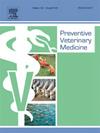猪流行性腹泻病毒RNA对养猪业运输工具污染的评价
IF 2.2
2区 农林科学
Q1 VETERINARY SCIENCES
引用次数: 0
摘要
猪流行性腹泻病毒(PEDV)是全球猪健康和福利最具破坏性的病原体之一。众所周知,受污染的污染物和车辆移动在PEDV农场到农场的传播中起着重要作用,但清洁和消毒(C&;D)方案对减少通过车辆和拖车传播风险的效果尚不清楚。本研究使用养猪业的数据来确定在开药前后车辆和拖车被PEDV RNA污染的频率。环境RNA样本是在北卡罗来纳州东部的三个C&;D站点从四种不同的车辆类型中收集的:工作人员卡车,饲料卡车,猪到农场的卡车和拖车,以及猪到市场的卡车和拖车。使用两种不同浓度的商业消毒剂,从C&;D前后的卡车车厢、拖车和轮胎中收集了总共2004份样本。内部RT-qPCR检测仅用于检测PEDV RNA的存在(不检测感染性状态)。结果表明,运输生猪的运货卡车最有可能感染PEDV(在C&;D之前,79.17 %的拖车检测为阳性,在C&;D之后,88.52 %的拖车检测为阳性),而饲料车感染PEDV的可能性最小(在C&;D之前,8.19 %的轮胎检测为阳性,在C&;D之后,15.12 %的轮胎检测为阳性)。基于PEDV RNA的检测,我们证明了季铵和戊二醛在消除可检测的PEDV RNA方面比过氧化氢更有效。研究结果还表明,卡车车厢与车辆外部一样受到污染。在此基础上,应对车辆生物安全措施进行评价和改进,以防止PEDV的传播。本文章由计算机程序翻译,如有差异,请以英文原文为准。
Evaluation of porcine epidemic diarrhea virus RNA contamination on swine industry transportation vehicles
Porcine epidemic diarrhea virus (PEDV) is one of the most devastating pathogens of global swine health and welfare. It is well known that contaminated fomites and vehicle movements play an important role in farm-to-farm PEDV spread, but the efficacy of cleaning and disinfection (C&D) protocols on the reduction in dissemination risk via vehicles and trailers remains unclear. This study used swine industry data to determine how frequently vehicles and trailers were contaminated with PEDV RNA before and after C&D. Environmental RNA samples were collected at three eastern North Carolina C&D sites from four different vehicle types: crew trucks, feed trucks, pigs-to-farm trucks and trailers, and pigs-to-market trucks and trailers. A total of 2004 samples were collected from truck cabins, trailers, and tires before and after C&D with two commercial disinfectants at two different concentrations. An in-house RT-qPCR assay was used to detect the presence of PEDV RNA only (not infectivity status). Results suggest that pigs-to-market trucks hauling live pigs were the most likely to be contaminated with PEDV (79.17 % of trailers tested positive before C&D and 88.52 % tested positive after C&D), while feed trucks were the least likely contaminated (8.19 % of tires testing positive before C&D and 15.12 % testing positive after C&D). Based on PEDV RNA detection, we demonstrated that quaternary ammonium and glutaraldehyde is a more effective disinfectant compared to advanced hydrogen peroxide in eliminating detectable PEDV RNA. Results also show that truck cabins are just as contaminated as the exterior of their vehicles. Based on these results, vehicle biosecurity measures should be evaluated and modified to prevent the spread of PEDV.
求助全文
通过发布文献求助,成功后即可免费获取论文全文。
去求助
来源期刊

Preventive veterinary medicine
农林科学-兽医学
CiteScore
5.60
自引率
7.70%
发文量
184
审稿时长
3 months
期刊介绍:
Preventive Veterinary Medicine is one of the leading international resources for scientific reports on animal health programs and preventive veterinary medicine. The journal follows the guidelines for standardizing and strengthening the reporting of biomedical research which are available from the CONSORT, MOOSE, PRISMA, REFLECT, STARD, and STROBE statements. The journal focuses on:
Epidemiology of health events relevant to domestic and wild animals;
Economic impacts of epidemic and endemic animal and zoonotic diseases;
Latest methods and approaches in veterinary epidemiology;
Disease and infection control or eradication measures;
The "One Health" concept and the relationships between veterinary medicine, human health, animal-production systems, and the environment;
Development of new techniques in surveillance systems and diagnosis;
Evaluation and control of diseases in animal populations.
 求助内容:
求助内容: 应助结果提醒方式:
应助结果提醒方式:


